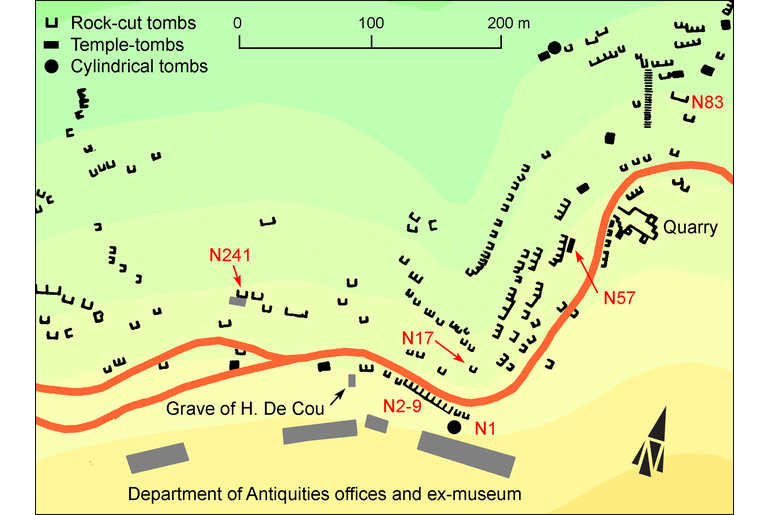Epitaph of Koison
GVCyr001
Trismegistos ID: 738897
Source Description
Repository
Cyrene Museum, 236.
Support
Two adjacent fragments pasted together of a limestone stele, broken above, chipped off below, with irregular depth (0.53; 0.80;0.04 (right) - 0.17 (left)).
Layout
Inscribed on front face in two lines (l. 1 ascending along the left edge, l. 2 descending along the right edge) (0.53; 0.72;).
Letters
0.06-0.075; boustrophedon, alpha with oblique central bar joining the second stroke very low (sometimes at its end), epsilon with three oblique and equal bars, three-stroke iota, dissymmetrical nu, san for sibilant.
Place of Origin
Findspot.
Date
First third of sixth century B.C. (lettering)
Findspot
Found before 1937 by Oliverio at Cyrene pleiades; HGL : North necropolis .
Last recorded Location
Seen by C. Dobias-Lalou in 1976 in Shahat : Cyrene Museum .
Text constituted from
Transcription from stone (CDL).
Bibliography
From †Oliverio's papers Pugliese Carratelli-Oliverio, 1961 Pugliese Carratelli, G., (from G. Oliverio), 1961, Iscrizioni cirenaiche, Quaderni di Archeologia della Libya (QAL)4, 3-54 - see in bibliography , n. 14, fig. 25-26, whence SEG Supplementum Epigraphicum Graecum, Leiden, then Amsterdam, 1923-1971, then 1979- - see in bibliography , 20.745; Dobias-Lalou, 1970 Dobias-Lalou, C., 1970, Pour une chronologie des inscriptions archaïques de Cyrène, Revue de Philologie, de Littérature et d'Histoire Anciennes (RPh)ser. 3, 44, 228-256 - see in bibliography , n. 4; Peek, 1972 Peek, W., 1972, Griechische Versinschriften aus der Cyrenaica aus Mauretanien und Numidien, Abhandlungen der sächsichen Akademie der Wissenschaften zu Leipzig, phil.-hist. Klasse, 63.4, Berlin - see in bibliography , n. 1; CEG Hansen, P.A. (ed.), Carmina epigraphica Graeca, I-II, Berlin, 1983-1989 - see in bibliography , n. 164. Cf. Gasperini, 2000 Gasperini, L., 2000, Scrittura e lingua: le fonti epigrafiche, in N. Bonacasa, S. Ensoli, et al. (eds.), Cirene, Centri e monumenti dell'antichità, Milano, 30-34 - see in bibliography , p. 31 (= Gasperini, 2008 Gasperini, L., and Arnaldi, A., Marengo, S.M. (eds.), 2008, Scritti di epigrafia greca, Ichnia10, Tivoli - see in bibliography , pp. 452-454).
Text
| ←Κ̣οίσōνος στάλα [ ˘ ˘ | ˉ ˘ ˘ | ˉ ˘ ˘ | ˉ ± ]
| → [ ˉ ˘ ˘ | ˉ ˘ ˘ | ˉ ˘ ˘ | ˉ ] ἔστασαν ἑταῖρ[οι]
Apparatus
1 Κ̣οίσōνος στάλα [---?] : Pugliese Carratelli-Oliverio, 1961
Pugliese Carratelli, G., (from G. Oliverio), 1961, Iscrizioni cirenaiche, Quaderni di Archeologia della Libya (QAL)4, 3-54 - see in bibliography
Κ̣οίσōνος (Hiller von Gaertringen's reading
per epistulam
) : Pugliese Carratelli-Oliverio, 1961
Pugliese Carratelli, G., (from G. Oliverio), 1961, Iscrizioni cirenaiche, Quaderni di Archeologia della Libya (QAL)4, 3-54 - see in bibliography
[Ἀ]λ̣((ϙ))ίσονος (Oliverio's reading ϙ inverted) : Peek, 1972
Peek, W., 1972, Griechische Versinschriften aus der Cyrenaica aus Mauretanien und Numidien, Abhandlungen der sächsichen Akademie der Wissenschaften zu Leipzig, phil.-hist. Klasse, 63.4, Berlin - see in bibliography
Κοίσōνος στάλα · φθι| : Peek, 1972
Peek, W., 1972, Griechische Versinschriften aus der Cyrenaica aus Mauretanien und Numidien, Abhandlungen der sächsichen Akademie der Wissenschaften zu Leipzig, phil.-hist. Klasse, 63.4, Berlin - see in bibliography
Κοίσōνος στάλα [το͂ Κάρνιος εἰμ' ἐπὶ τύμβōι·]
2
[---?] ἔστασαν ἑταῖρ[οι] : Peek, 1972
Peek, W., 1972, Griechische Versinschriften aus der Cyrenaica aus Mauretanien und Numidien, Abhandlungen der sächsichen Akademie der Wissenschaften zu Leipzig, phil.-hist. Klasse, 63.4, Berlin - see in bibliography
|[μένōι δ']ἔστασαν ἑταῖρο[ι] : Peek, 1972
Peek, W., 1972, Griechische Versinschriften aus der Cyrenaica aus Mauretanien und Numidien, Abhandlungen der sächsichen Akademie der Wissenschaften zu Leipzig, phil.-hist. Klasse, 63.4, Berlin - see in bibliography
[νούσōι δὲ φθιμένōι μνάμαν μ']ἔστασαν ἑταῖρο[ι]
French translation
La stèle de Koisôn [---?] a été dressée par ses compagnons.
English translation
The stele of Koison [---?] was erected by his companions.
Italian translation
La stele di Koison [---?] è stata eretta dai suoi compagni.
Arabic translation
لوح كويسون التذكاري [---؟] كان قد نصب من قبل أصحابه.
Commentary
This being the only inscription written boustrophedon, we catch from Bertarelli, 1937 Bertarelli, L.V., 1937, Libia, Guida d'Italia del Touring Club Italiano, Milano - see in bibliography , p. 413 that it was already exposed at the time in room 2 of the then Antiquarium (today Office of the Department of Antiquities).
As both short ends of the stone are broken off, its original dimensions and placement are impossible to infer, except from the content.
As the word 'stele' and the verb meaning 'to erect' show, this was a standing stone to be read looking from the centre alternatively to one and the other longer side. The verb being usually at the end of a sentence and the deceased person's name being an important information at the beginning of the text, it can be inferred that the first line is to be read at left from below upwards and the second line from above downwards.
Depending on the following formula, the first word 'stele' should be used at the accusative, in relation with the verb 'to erect' or at another case if the text had two sentences.
Metrical analysis: Peek's preferred restoration, producing only one dactylic hexameter, supposes a moderate loss of the upper part. This reading is quite possible. However we left the question open in the translation for an alternative reading, supposing that more than one half of the stone might be lost. This would provide a distich made of two dactylic hexameters, a solution for which Peek also offered less cautious restorations.
Creative Commons Attributions-NonCommercial 4.0 International License.
All citation, reuse or distribution of this work must contain a link back to DOI: http://doi.org/10.6092/UNIBO/IGCYRGVCYR and the filename (IGCyr000000 or GVCyr000), as well as the year of consultation.
